From the diminutive Rusty-spotted cat in Sri Lanka to the imposing Siberian tiger in the Russian Far East, the wild cat family (Felidae) encompasses an astonishing 41 species, each showcasing unique beauty and adaptations. While iconic big cats like lions, tigers, jaguars, and leopards are widely recognized, a vast array of lesser-known wild cat types exists. If you’re captivated by felines or simply intrigued by these charismatic creatures, delve into this guide to discover the fascinating diversity within the wild cat family.
Driven by a lifelong passion for wildlife, I embarked on a personal quest to observe every wild cat species in their natural habitats. This ambitious endeavor is an ongoing journey, as some species are incredibly elusive and rarely encountered. To date, I have been fortunate enough to witness 21 distinct wild cat species. In this article, I will share insights and recommendations on prime locations and tours for those inspired to embark on their own wild cat spotting adventures.
For up-to-date information on recent wild cat sightings and other mammal observations, mammalwatching.com stands as an invaluable resource. This platform allows wildlife enthusiasts worldwide to share their trip reports, providing crucial intelligence for anyone seeking to track down specific felid species.
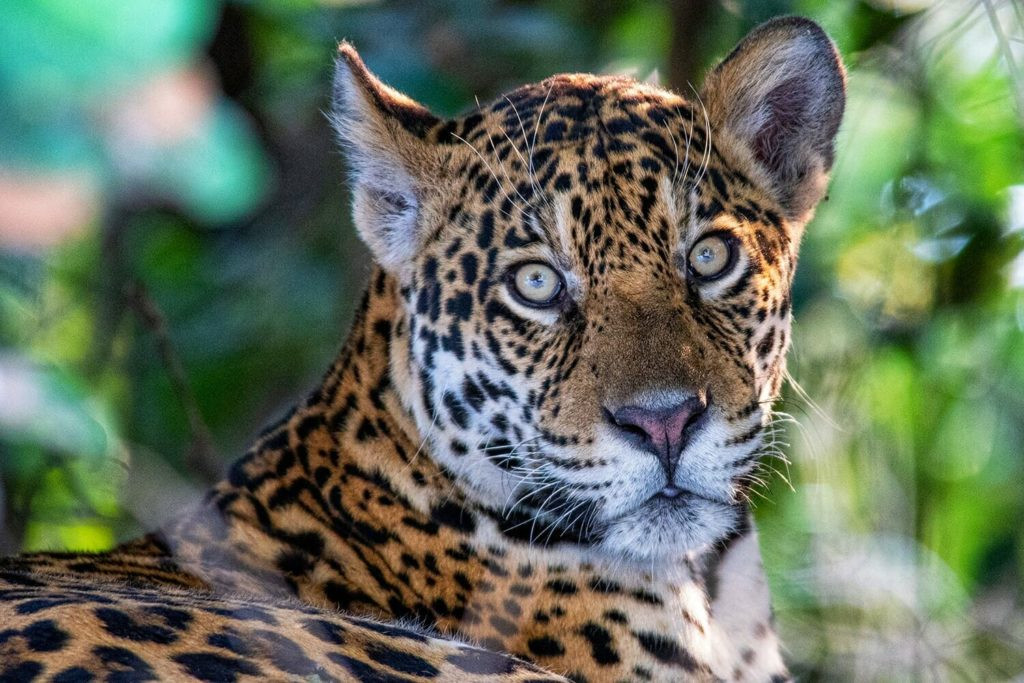 Wild cats lower classification – Jaguar resting on the bank of Cuiaba river in Porto Jofre, Brazil
Wild cats lower classification – Jaguar resting on the bank of Cuiaba river in Porto Jofre, Brazil
Understanding the Number of Wild Cat Species
The exact number of recognized wild cat species is subject to ongoing scientific discussion and refinement. However, the consensus among experts is that the Felidae family is structured into eight distinct lineages. As of November 2017, the Cat Specialist Group of the International Union for Conservation of Nature (IUCN), a leading authority in feline conservation, recognizes 41 species within Felidae, inclusive of the domestic cat.
The Felidae family is further categorized into two subfamilies: Pantherinae, which includes the seven iconic “big cats,” and Felinae, representing the 33 “small cat” species. This classification provides a framework for understanding the evolutionary relationships and diverse characteristics within the wild cat family.
The Majestic Seven: Exploring the Big Cat Species
The “big cats” are characterized by their larger size and belong to the Pantherinae subfamily. These awe-inspiring predators are:
- Lion
- Tiger
- Jaguar
- Leopard
- Snow Leopard
- Clouded Leopard
- Sunda Clouded Leopard
Facing Extinction: The Most Endangered Wild Cat Species
The IUCN Red List of Threatened Species serves as a critical barometer of species conservation status. Currently, five wild cat species are classified as Endangered, highlighting the urgent need for conservation efforts:
- Tiger
- Iberian Lynx
- Borneo Bay Cat
- Fishing Cat
- Flat-headed Cat
Below is a detailed classification of wild cats, featuring all 40 wild species (excluding the domestic cat), categorized by lineage and conservation status.
Big Cat Species – Panthera Lineage: Giants in Peril
Big cats are not only among the most charismatic animals on Earth but also face some of the most severe threats to their survival. These magnificent creatures, belonging to the Pantherinae subfamily, are often symbols of wilderness and power, yet their populations are increasingly vulnerable.
Tiger (Panthera tigris)
Siberian tiger IUCN Status: Endangered
The Siberian tiger, the largest living cat species, can reach weights of up to 320 kg. Tragically, this apex predator is also the most endangered among the big cats. Historically, tigers roamed vast territories, including Turkey and the Indonesian islands of Bali and Java. However, the subspecies inhabiting these regions are now extinct. The South China tiger is critically close to extinction, with possibly only around 20 individuals remaining in the wild. The remaining five tiger subspecies are also experiencing population declines.
The Siberian tiger itself narrowly escaped extinction. In the 1940s, their numbers dwindled to a mere 40 in the expansive Siberian forests. Dedicated conservation efforts in the Russian Far East have been instrumental in bringing this majestic cat back from the brink.
Today, the majority of the global tiger population belongs to the Bengal subspecies, primarily found in the Indian subcontinent. India stands out as the premier destination for observing tigers in their natural habitat. Renowned national parks like Kanha and Bandhavgarh, located in Madhya Pradesh, offer exceptional tiger sighting opportunities.
During a visit to Kanha National Park, I personally witnessed 15 tigers over seven days, including solitary individuals, a mating pair, and a tigress with her three cubs.
Lion (Panthera leo)
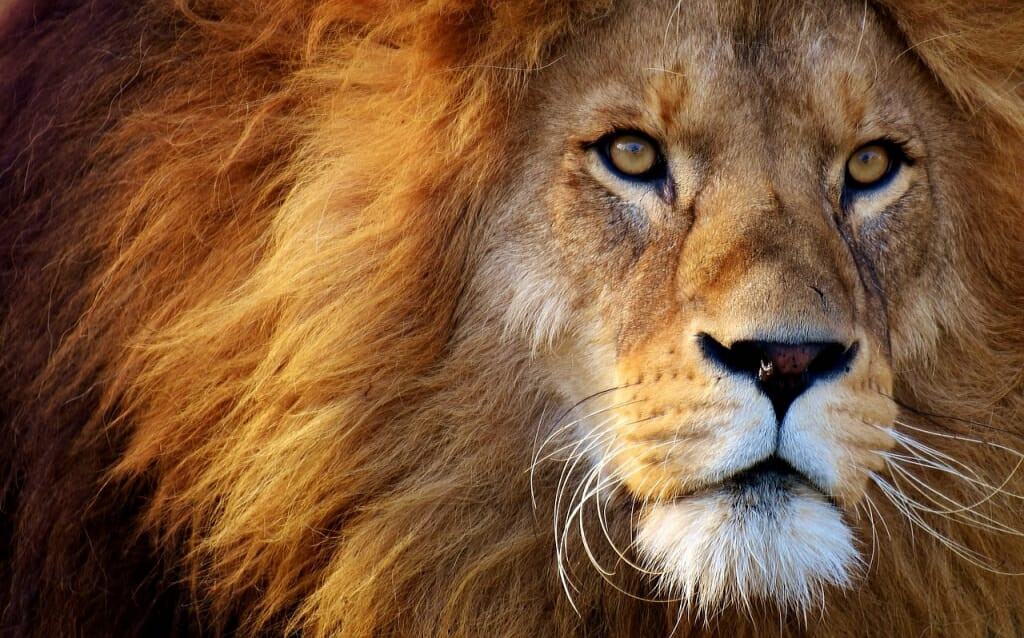 African lion IUCN Status: Vulnerable
African lion IUCN Status: Vulnerable
Lions, the second-largest cat species, once inhabited most of Africa, parts of Europe, and Asia. Today, their distribution is fragmented, primarily restricted to sub-Saharan Africa, with a critically endangered population persisting in India. The Barbary lion, once a majestic presence in Egypt, Morocco, and Algeria, is now extinct.
Historically, lions were broadly categorized into African and Asiatic lions. However, recent genetic studies indicate that Asiatic lions belong to the same subspecies as the Northern lion, which also encompasses the Critically Endangered West African and Central African lion populations. Southern and East African lions constitute a separate subspecies.
Southern and East African lions are frequently observed on classic African safaris. For those seeking the Asiatic lion, Gir National Park in Gujarat, India, is the sole refuge.
My lion sightings include experiences in Kruger National Park and adjacent sanctuaries. A particularly memorable encounter was observing a pride of rare white lions in Timbavati. Kgalagadi Transfrontier Park in South Africa and Etosha National Park in Namibia are also excellent locations for lion viewing.
Leopard (Panthera pardus)
African leopard IUCN Status: Vulnerable
The leopard, surprisingly, has the most extensive distribution of all big cats, spanning sub-Saharan Africa, Central Asia, the Indian subcontinent, and Southeast Asia. While certain leopard subspecies are highly endangered, the species, as a whole, was once considered relatively secure. However, it’s now understood that leopards have lost approximately 75% of their historical range, and their populations are continuing to decline.
Africa and Sri Lanka are considered leopard hotspots. In Africa, prime leopard viewing locations include Maasai Mara National Park (Kenya), Kruger National Park (South Africa), Serengeti National Park (Tanzania), and numerous other national parks in southern and eastern Africa.
For those traveling to Sri Lanka, consider Wilpattu National Park as an alternative to the often overcrowded Yala National Park, which can negatively impact animal welfare.
Adventurous travelers can explore the Russian Far East with Bohai tours in pursuit of the Critically Endangered Amur leopard, the rarest big cat subspecies. Encouragingly, their numbers have slowly increased from around 35 in the 1980s to over 100 in 2017.
Learn more about distinguishing these spotted cats: Jaguar vs. Leopard: Telling the Difference.
Jaguar (Panthera onca)
 Wild cats lower classification – Jaguar resting on the bank of Cuiaba river in Porto Jofre, Brazil Image by The Wildlife Diaries. IUCN Status: Near Threatened
Wild cats lower classification – Jaguar resting on the bank of Cuiaba river in Porto Jofre, Brazil Image by The Wildlife Diaries. IUCN Status: Near Threatened
Jaguars stand out as the most aquatic among big cats, demonstrating remarkable swimming abilities and frequently resting on tree branches overhanging rivers. They also possess the most powerful bite force relative to their body size among big cats, capable of crushing an adult caiman’s skull – a favored prey in the Pantanal.
Uniquely, jaguars maintain a single continuous population across their vast 6-million sq. km range, encompassing 18 countries, with no recognized subspecies. This wide-ranging, genetically connected population presents unique conservation challenges. Efforts are focused on protecting habitat corridors that facilitate movement and maintain gene flow between jaguar populations.
In 2018, the United Nations Development Programme launched the Jaguar 2030 program, a comprehensive initiative aimed at jaguar conservation across their entire geographic range.
The Amazon and the Pantanal in Brazil are jaguar strongholds. However, the Pantanal, particularly the Porto Jofre region along the Cuiaba River, offers superior jaguar viewing opportunities. When planning a Pantanal tour with jaguar sightings in mind, ensure your base is in Porto Jofre.
Explore further: Jaguar Watching in the Pantanal
Snow Leopard (Panthera uncia)
Snow leopard IUCN Status: Vulnerable
The snow leopard, often called the “Ghost of the Mountains,” is the most elusive of the big cats. A Nepalese saying even suggests that spotting a snow leopard is more challenging than seeing God. These enigmatic cats inhabit the harsh, high-altitude mountain ranges of Central Asia, with individuals roaming vast territories.
Despite their elusive nature, snow leopards are regularly sighted in Hemis National Park in India. However, this is an adventure for the intrepid, involving camping in sub-zero temperatures (-20 degrees Celsius) and patiently scanning mountain valleys for extended periods. The snow leopard’s grey fur with black blotches provides exceptional camouflage, allowing it to blend seamlessly into its rocky environment.
Clouded Leopard (Neofelis nebulosa)
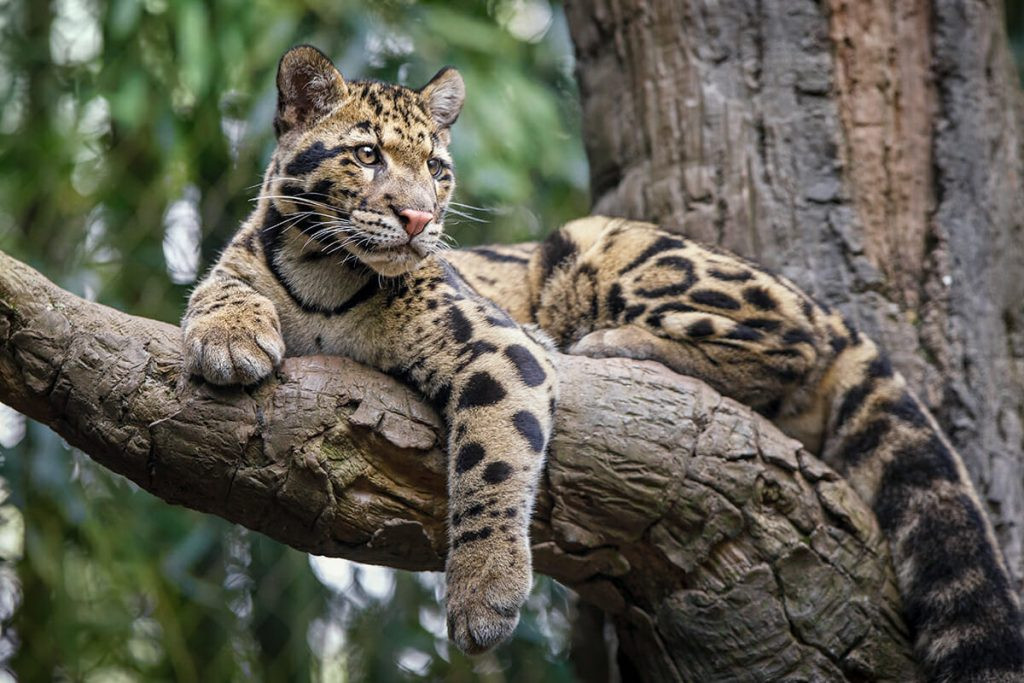 Bhutan wildlife – clouded leopard Clouded leopard IUCN Status: Vulnerable
Bhutan wildlife – clouded leopard Clouded leopard IUCN Status: Vulnerable
The clouded leopard, the smallest of the big cat species, is renowned for its acrobatic prowess. It is among the most skilled climbers in the wild cat family. Its flexible ankle joints enable it to descend trees headfirst, hang from branches using its hind feet and tail, and even climb horizontally with its back to the ground.
Beyond climbing, clouded leopards are unique among big cats for their ability to purr and possess the longest canine teeth relative to their body size, earning them the nickname “modern-day sabre-tooth.”
Like other big cats, clouded leopards face extinction threats. The global population is estimated to be fewer than 10,000 mature individuals and is declining. Their secretive nature has hindered comprehensive study, and their populations could be smaller than current estimates suggest.
While clouded leopards range from the Himalayan foothills across Southeast Asia, sightings in the wild are rare. Occasionally, they are spotted on wildlife safaris in India.
Sunda Clouded Leopard (Neofelis diardi)
Sunda Clouded Leopard. Image @ Mike Gordon – Adventure Alternative Borneo / Wildlife of Asia IUCN Status: Vulnerable
Until 2016, the clouded leopard was considered a single species. However, genetic analysis revealed that clouded leopards inhabiting Borneo and Sumatra are distinct species, diverging from mainland clouded leopards approximately 1.5 million years ago.
The Sunda clouded leopard, endemic to these islands, is slightly smaller and darker than its mainland counterpart. Until recently, Sunda clouded leopard sightings were as infrequent as mainland clouded leopard encounters.
However, Deramakot Forest Reserve in Sabah, Malaysian Borneo, has emerged as a promising location for spotting these elusive felines. While sightings aren’t guaranteed, Deramakot offers the best opportunity to witness a Sunda clouded leopard.
Small Cat Species: Hidden Gems of the Felidae Family
While big cats command global attention, small cats comprise the majority of wild cat species. Found across all continents except Antarctica and Australia, they exhibit remarkable diversity in size, habitat, and behavior. Australia, notably, hosts a large feral cat population descended from domestic cats introduced by European settlers.
Bay Cat or Pardofelis Lineage: Asian Rarity
The Bay cat lineage, the second to diverge from the common feline ancestor, encompasses three species, all native to Southeast Asia. This lineage represents some of the most elusive and least-known Asian wild cats.
Borneo Bay Cat (Catopuma badia)
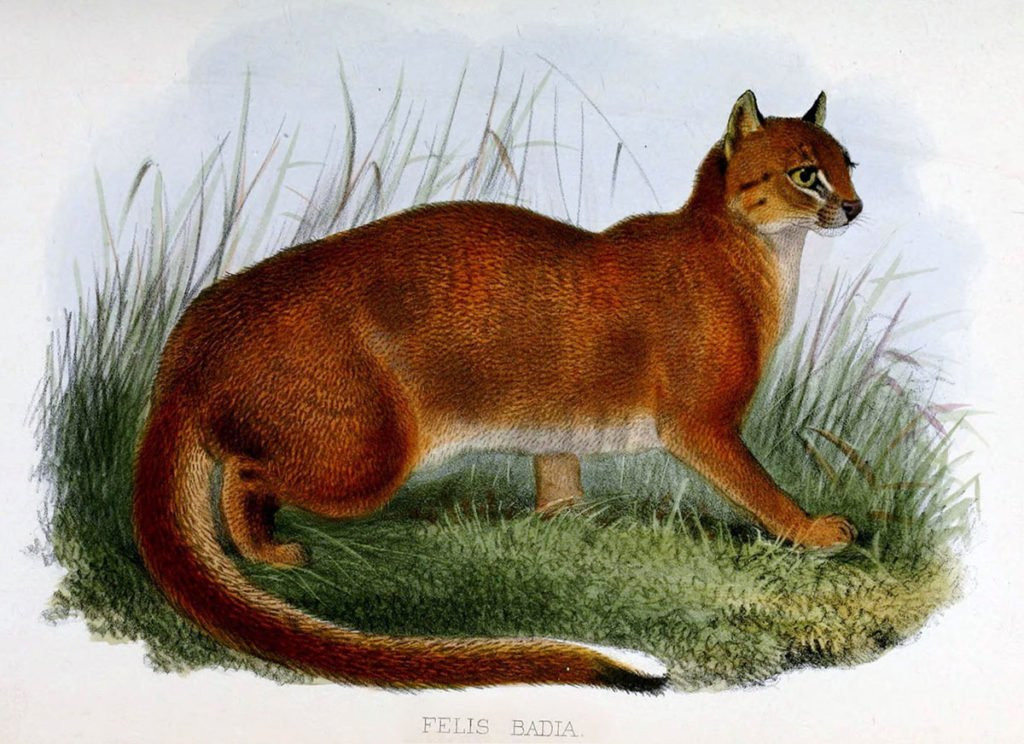 The Borneo Bay cat, a mysterious and endangered feline, remains largely unknown to science. Bay cat. Image @ Jim Sanderson via Wikipedia Creative Commons IUCN Status: Endangered
The Borneo Bay cat, a mysterious and endangered feline, remains largely unknown to science. Bay cat. Image @ Jim Sanderson via Wikipedia Creative Commons IUCN Status: Endangered
The endangered Borneo Bay cat is considered the holy grail for wild cat enthusiasts. Endemic to Borneo, it remains shrouded in mystery since its scientific description in 1874. These exceptionally secretive cats are rarely observed in the wild, and much about their ecology remains unknown.
Unlike clouded leopards, marbled cats, and leopard cats inhabiting Borneo, bay cats appear to avoid forest trails, making camera trapping and direct observation extremely challenging. Locating them in their dense forest habitat is a significant hurdle for researchers and wildlife observers alike.
Asiatic Golden Cat (Catopuma temminckii)
Juvenile Asiatic golden cat. Image @ Tambako The Jaguar – via Flikr Creative Commons IUCN Status: Near Threatened
The Asiatic Golden cat, another rarely seen feline, has a wide but fragmented distribution from India to Malaysia. It is present on Sumatra but absent from other Indonesian islands.
Preferring forested habitats, Asiatic golden cats are crepuscular and diurnal, exhibiting activity peaks around dawn, dusk, and during daylight hours. While skilled climbers, they primarily hunt on the ground, capable of taking down prey significantly larger than themselves, including young water buffalo calves.
Currently, no reliable locations guarantee Asiatic golden cat sightings, with most accidental encounters occurring in Indonesia.
Marbled Cat (Pardofelis marmorata)
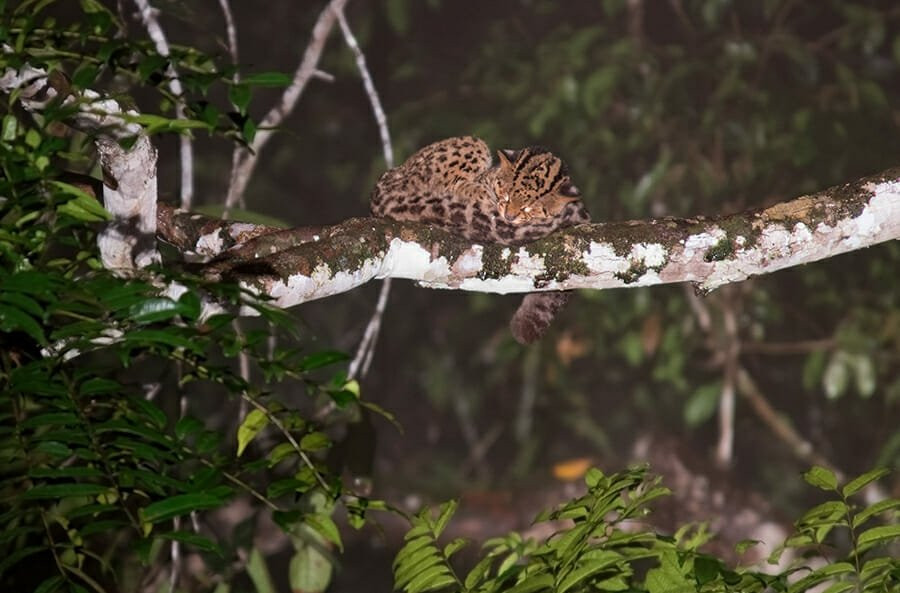 Wild cat species of the world – Marbled cat in Deramakot Forest Reserve Marbled cat in Deramakot Forest Reserve (Image by The Wildlife Diaries) IUCN Status: Near Threatened
Wild cat species of the world – Marbled cat in Deramakot Forest Reserve Marbled cat in Deramakot Forest Reserve (Image by The Wildlife Diaries) IUCN Status: Near Threatened
The marbled cat, admired for its striking coat pattern and exceptionally long tail, is among the most visually appealing small cats. Its range extends from the Himalayan foothills to Malaysia and the islands of Sumatra and Borneo. Primarily arboreal, marbled cats are believed to spend much of their lives in trees.
I have had the privilege of observing marbled cats on multiple trips to Deramakot Forest Reserve in Borneo. On my second visit, we observed two individuals in the same tree, likely an adult and a sub-adult kitten.
Caracal Lineage: African and Asian Mid-Sized Cats
The Caracal lineage, the third oldest, includes three medium-sized species predominantly found in Africa.
Serval (Leptailurus serval)
Serval IUCN Status: Least Concern
The serval, with its distinctive long legs, large ears, and short tail, is an unusual-looking cat. These adaptations are crucial for locating prey in the tall grasslands they inhabit. While widespread in Southern Africa, servals are less common in the northern parts of the continent. These agile felines can leap up to 3.6 meters vertically to precisely capture prey, even with eyes closed.
Servals are surprisingly abundant in the Ngorongoro Conservation Area in Tanzania. Another unexpected location for serval sightings is Secunda, South Africa, home to the world’s largest coal liquefaction plant. The high serval density in this seemingly industrial habitat is attributed to abundant prey, such as vlei rats, and the absence of larger carnivores.
African Golden Cat (Caracal aurata)
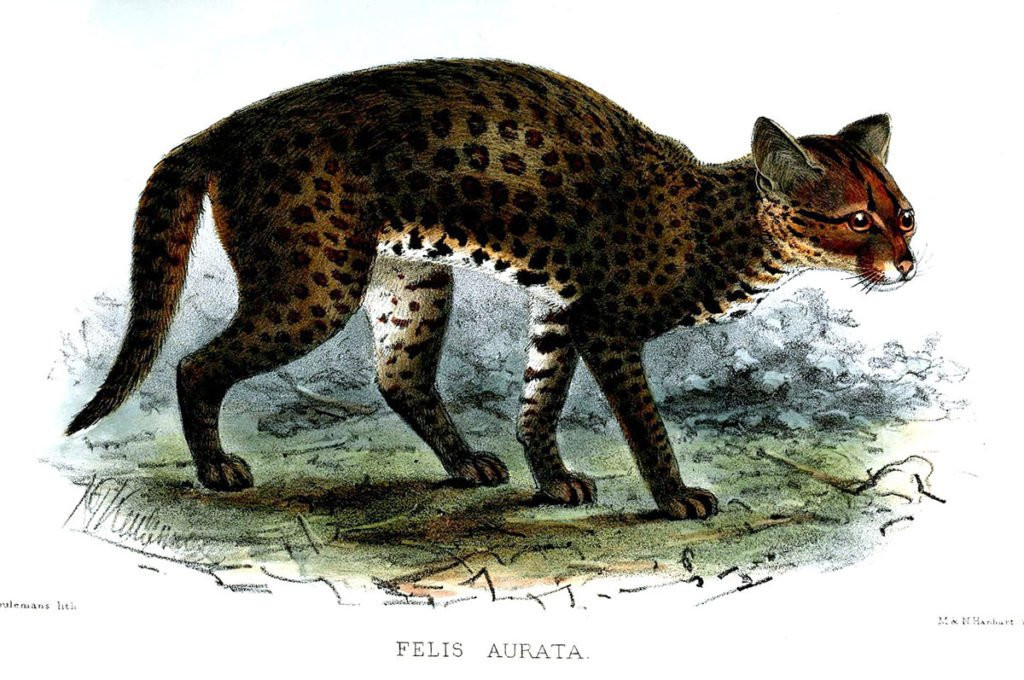 The African golden cat, one of the rarest and least observed wild cats in Africa. African golden cat. Image @ By John Gerrard Keulemans via Wikipedia Creative Commons IUCN Status: Vulnerable
The African golden cat, one of the rarest and least observed wild cats in Africa. African golden cat. Image @ By John Gerrard Keulemans via Wikipedia Creative Commons IUCN Status: Vulnerable
The African Golden cat, one of the rarest wild cat species and the rarest wild cat in Africa, inhabits the rainforests of West and Central Africa. Its preference for dense tropical forest makes it exceptionally challenging to spot in the wild.
Some sightings have been reported in the Libongo Forest Concession in Cameroon, where they appear to be relatively common along access roads.
Caracal (Caracal caracal)
Caracal IUCN Status: Least concern
The caracal is unique within the Caracal lineage for its distribution extending beyond Africa into the Middle East, Central Asia, and India. Its name, derived from the Turkish word “karakulak,” meaning “black ears,” refers to its distinctive jet-black ears topped with tufts. Another acrobatic feline, the caracal can leap 3 meters into the air and snatch multiple birds in a single bound.
While generally secretive, caracals are frequently observed in South African parks and game reserves (Kgalagadi NP, West Coast NP, Mosaic Farms). I was fortunate to spot a caracal family in Ranthambhore National Park in India, where they are rarely seen.
Ocelot or Leopardus Lineage: Latin American Diversity
The Ocelot lineage is the most diverse within the wild cat family, comprising eight small spotted cat species, all native to Latin America. This lineage stands apart genetically, with members possessing 36 chromosomes instead of the typical 38 found in other lineages.
Ocelot (Leopardus pardalis)
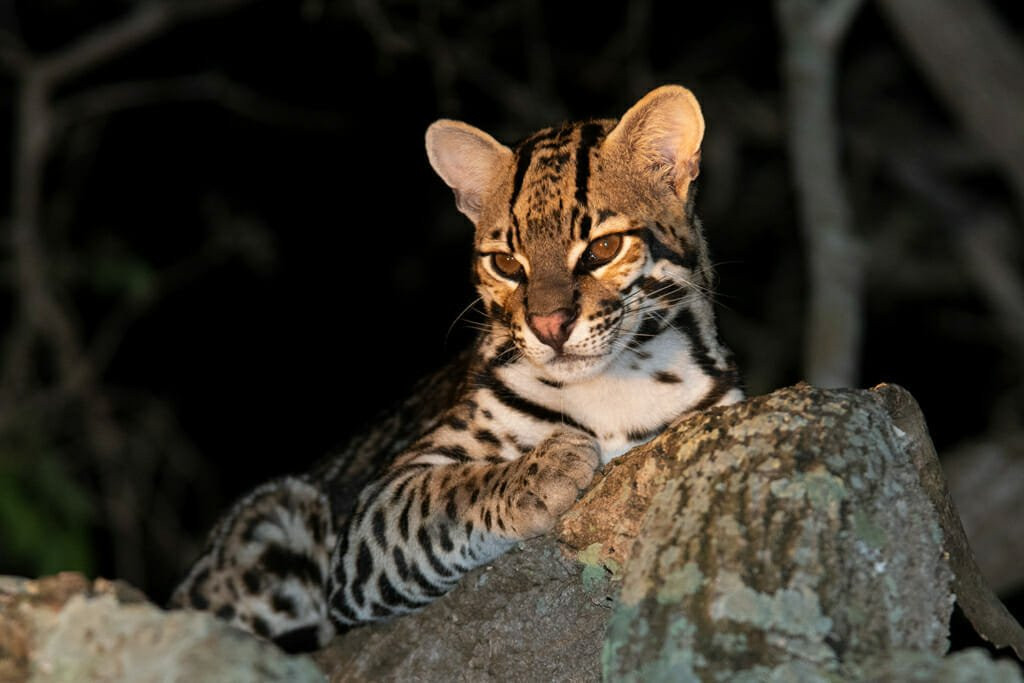 wild cat species of the world – Ocelot in the Southern Pantanal, Brazil Female Ocelot in the Brazilian Pantanal, Fazenda San Francisco (Image by The Wildlife Diaries) IUCN Status: Least Concern
wild cat species of the world – Ocelot in the Southern Pantanal, Brazil Female Ocelot in the Brazilian Pantanal, Fazenda San Francisco (Image by The Wildlife Diaries) IUCN Status: Least Concern
The ocelot’s range extends across South America, Central America, Mexico, and southern Texas. It is arguably the most common, or rather, least uncommon, of South American wild cats.
Barro Colorado Island in Panama boasts the highest ocelot population globally. The Transpantaneira highway in Brazil’s northern Pantanal is also a promising location for spotting these spotted hunters.
However, the San Francisco Farm in the southern Pantanal is arguably the best place for ocelot encounters. I have observed three ocelots on a single night drive there, with all sightings being relaxed and at close range.
Margay (Leopardus wiedii)
Margay IUCN Status: Near Threatened
Resembling the larger ocelot in appearance, the margay is a far more adept climber. Unlike ocelots, margays spend the majority of their lives in trees. They are one of only three wild cat species with flexible ankle joints, allowing them to descend trees headfirst (the others being the clouded leopard and marbled cat).
Margays can hunt entirely within trees, and have been observed mimicking the alarm calls of baby pied tamarins to ambush them.
Arboreal cats are typically more challenging to spot than ground-dwelling species. Wildsumaco Lodge in Ecuador is reportedly a good location for margay sightings.
Colocolo (Leopardus colocolo)
 Colocolo Colocolo IUCN Status: Near Threatened
Colocolo Colocolo IUCN Status: Near Threatened
The colocolo encompasses small wild cats previously classified as three separate species: colocolo (L. colocolo), Pantanal cat (L. braccatus), and Pampas cat (L. pajeros). Recent taxonomic revisions by the Cat Specialist Group have consolidated them into a single species, colocolo or Pampas cat, ranging across much of Argentina and Uruguay into Bolivia, Paraguay, Brazil, and Ecuador.
I missed seeing the colocolo at Fazenda San Francisco in the Southern Pantanal, Brazil, where they are sighted approximately once a week.
Northern Oncilla (Leopardus tigrinus)
Oncilla IUCN Status: Vulnerable
The oncilla resembles the ocelot and margay but is smaller in size. Recently, the oncilla has been divided into two distinct species: Northern Oncilla and Southern Oncilla. The Northern Oncilla is found in Central America, Venezuela, Guyana, and northeastern Brazil.
Ecuador is considered a prime location for oncilla sightings, particularly at Bellavista Lodge and Cabanas San Isidro Lodge. Oncillas are also occasionally observed in the Brazilian Pantanal.
Southern Oncilla (Leopardus guttulus)
IUCN Status: Vulnerable
The Southern oncilla is distributed across central and southern Brazil, Uruguay, Paraguay, and northern Argentina.
Guina (Leopardus guigna)
 Kodkod by Far South Expeditions Guina on Chiloe Island, Chile (Far South Expeditions) IUCN Status: Vulnerable
Kodkod by Far South Expeditions Guina on Chiloe Island, Chile (Far South Expeditions) IUCN Status: Vulnerable
Also known as the Kodkod, the guina is South America’s smallest wild cat species. It primarily inhabits south and central Chile, with its range extending into adjacent areas of Argentina. An agile climber, the guina primarily hunts on the ground, preying on small mammals, birds, lizards, and insects.
Guinas typically have brownish-yellow to grey-brown coats with dark spots, but melanistic (black) morphs are also relatively common.
Parque Tepuhueico on Chiloe Island in Chile is a good place to spot guinas in the wild, including melanistic individuals.
Geoffroy’s Cat (Leopardus geoffroyi)
Black Geoffroy’s cat in El Palmar National Park, Argentina (Image by The Wildlife Diaries) IUCN Status: Least Concern
Resembling the guina but larger, Geoffroy’s cat has a broader distribution from Southern Bolivia to the Straits of Magellan. Uniquely, this species often stands upright, using its tail for balance to survey its surroundings.
Its preference for dense habitats makes Geoffroy’s cat difficult to spot. Similar to the guina, Geoffroy’s cat typically has a tawny coat with black spots, although black morphs are also not uncommon.
El Palmar National Park in Argentina is a good location for sightings. During a visit to El Palmar during unusually rainy weather in early September, it took three nights to spot a single cat, a striking black morph.
Andean Cat (Leopardus jacobita)
 Rarest wild cats – Andean mountain cat
Rarest wild cats – Andean mountain cat
The Andean Mountain Cat, one of the rarest wild cats, adapted to high-altitude environments. Andean Mountain Cat (Juan Reppucci – Andean Cat Alliance) IUCN Status: Endangered
One of the world’s rarest cats, the endangered Andean cat, inhabits high elevations in the Andes Mountains across Southern Argentina, Chile, Bolivia, and Peru. Similar to its larger high-altitude relative, the snow leopard, the Andean cat is rarely seen. It favors steep, arid, sparsely vegetated, rocky terrain where it hunts mountain viscachas.
Lauca National Park and Salar de Surire National Monument in Chile are suggested as potential areas for Andean cat sightings.
Lynx Lineage: Short-Tailed Hunters
The Lynx lineage comprises four species, all sharing similar characteristics: short tails and tufted ears, adapted for colder climates and specialized hunting.
Canada Lynx (Lynx canadensis)
Canada lynx IUCN Status: Least Concern
The Canada lynx, the northernmost lynx species, ranges across Alaska, Canada, and the northern United States. Its most distinctive feature is its large paws covered in dense fur. These oversized paws act as snowshoes, enabling the Canada lynx to traverse snow-covered landscapes without sinking.
Lake Superior in Minnesota is reportedly a good place to spot the Canada lynx.
Iberian Lynx (Lynx pardinus)
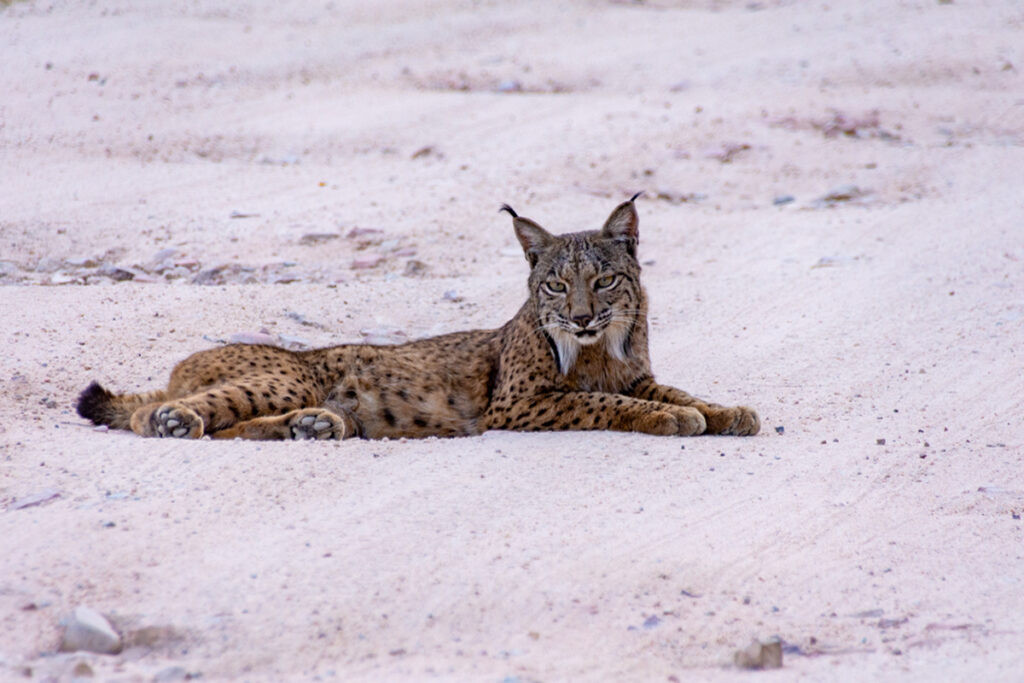 Rafiki – Iberian lynx in Sierra de Andujar Iberian lynx named Rafiki in Sierra de Andujar Natural Park IUCN Status: Vulnerable
Rafiki – Iberian lynx in Sierra de Andujar Iberian lynx named Rafiki in Sierra de Andujar Natural Park IUCN Status: Vulnerable
The Iberian lynx faced near extinction, with fewer than 100 individuals remaining in isolated Mediterranean scrubland patches in Spain by 2002. Recognizing the critical situation, intensive conservation efforts were implemented.
After two decades of dedicated protection and conservation programs, the Iberian lynx population in Spain and Portugal has rebounded to over 2,000 individuals by 2024. Sierra de Andujar Natural Park, just over 100km from Cordoba, is now the premier location for Iberian lynx sightings. Numerous wildlife tour agencies offer specialized Iberian lynx tours.
During my PhD fieldwork in Sierra de Andujar in 2022, I had the remarkable opportunity to observe a female lynx raising a litter of three cubs, witnessing her hunting, nursing, and interactions with her older daughter. This park offers unparalleled opportunities to witness the private lives of these secretive felids.
Eurasian Lynx (Lynx lynx)
Eurasian lynx IUCN Status: Least Concern
The Eurasian lynx, the largest lynx species, has the broadest distribution, spanning Siberia, Asia, and Eastern Europe. While not currently threatened, the Eurasian lynx is elusive and difficult to spot in the wild.
Reliable locations for Eurasian lynx sightings are scarce. However, they are occasionally observed on snow leopard tours in Hemis National Park in India.
Bobcat (Lynx rufus)
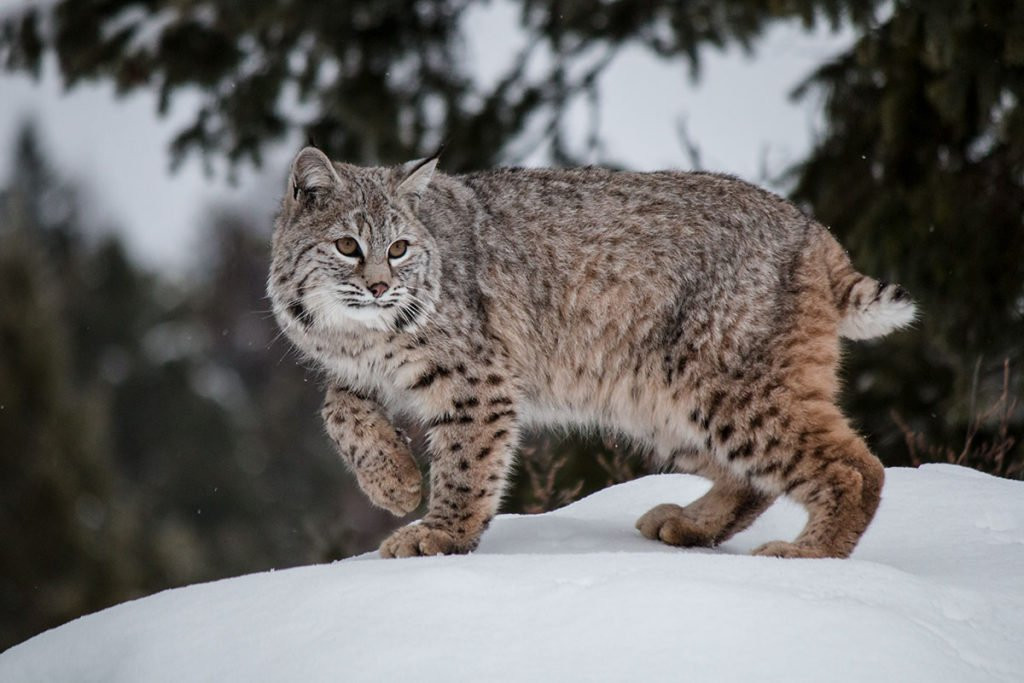 Fluffy wild cat – bobcat Bobcat IUCN Status: Least Concern
Fluffy wild cat – bobcat Bobcat IUCN Status: Least Concern
The bobcat, similar in appearance to the Canada lynx, ranges from southern Canada to central Mexico. Smaller than the Canada lynx, it is still about twice the size of a domestic cat. Its name originates from its short, “bobbed” tail. Like other lynx species, bobcats primarily prey on rabbits but also consume insects, chickens, birds, rodents, and even deer.
Bobcats are generally common, and Point Reyes National Seashore near San Francisco is a good place to observe them.
Puma Lineage: An Unusual Feline Trio
The Puma lineage presents a unique combination of feline species: one typical small cat and two oversized small cats, showcasing evolutionary diversity within the family.
Puma (Puma concolor)
Puma in Corcovado National Park. Image by The Wildlife Diaries
IUCN Status: Least Concern
Despite its considerable size, the puma, also known as cougar or mountain lion, is classified as a small cat, not belonging to the big cat subfamily. Its range extends across South America, Mexico, the United States, and parts of southern Canada.
Torres del Paine National Park in Chile is renowned as the best location for puma sightings. I personally observed a puma with two sub-adult cubs in Puma Valley in Corcovado National Park in Costa Rica.
Cheetah (Acinonyx jubatus)
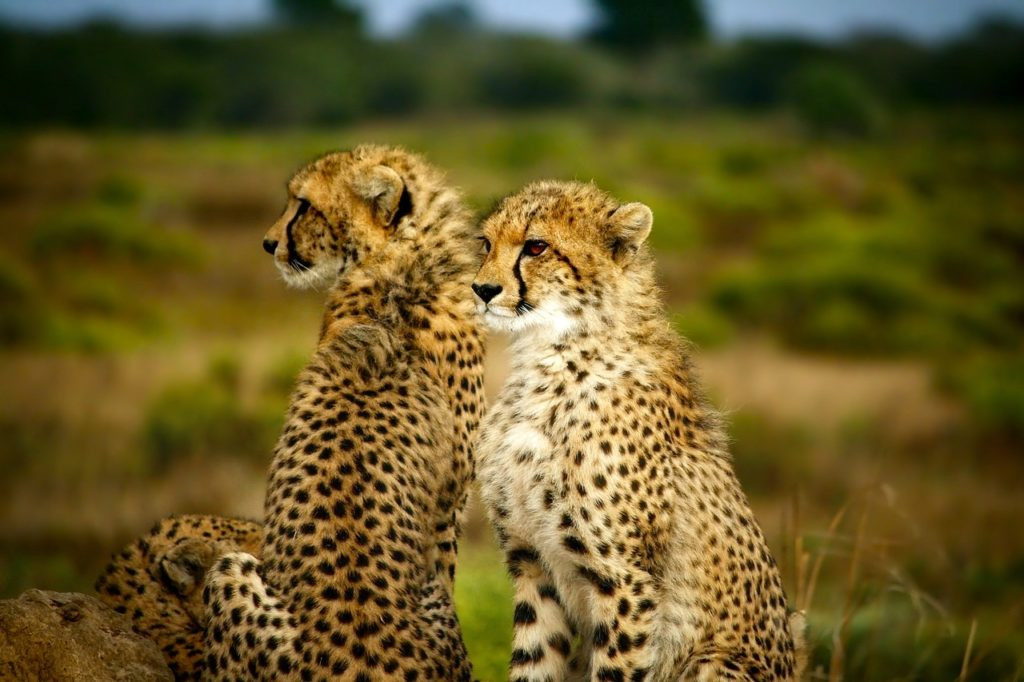 fastest wild cats – heetahs Young cheetahs IUCN Status: Vulnerable
fastest wild cats – heetahs Young cheetahs IUCN Status: Vulnerable
The cheetah holds the title of the fastest land animal, accelerating from 0 to 96 km/h in just three seconds. Beyond speed, cheetahs are remarkably agile at high velocities, capable of making sharp turns while pursuing prey. They are also well-adapted to arid environments, needing to drink only once every four days.
Cheetahs are found in Southern, North, and East Africa, with a small, critically endangered population in Iran. The Iranian population, known as the Asiatic or Persian cheetah, numbers fewer than 50 individuals scattered across a vast 140,000 km2 plateau.
African cheetahs are relatively easy to observe on safari. Excellent viewing locations include Serengeti National Park (Tanzania), Maasai Mara (Kenya), Kgalagadi Transfrontier Park (South Africa), and Etosha National Park in Namibia. I observed a mother cheetah and her cub at a kill in Kruger National Park in South Africa.
Jaguarundi (Herpailurus yagouaroundi)
Jaguarundi grey and chestnut morphs IUCN Status: Least Concern
The jaguarundi, with its short legs and elongated body, is an unusual-looking cat. Its unspotted coat, similar to the puma, contrasts with other South American cats. It inhabits southern North America and South America.
While not considered threatened, jaguarundis are not easily observed in the wild. Most sightings occur in South America, typically by chance during daylight hours.
Leopard Cat or Prionailurus Lineage: Asian Small Cat Radiance
The Leopard Cat lineage comprises six small wild cat species, all with an Asian distribution, showcasing the rich feline diversity of the continent.
Pallas’s Cat (Otocolobus manul)
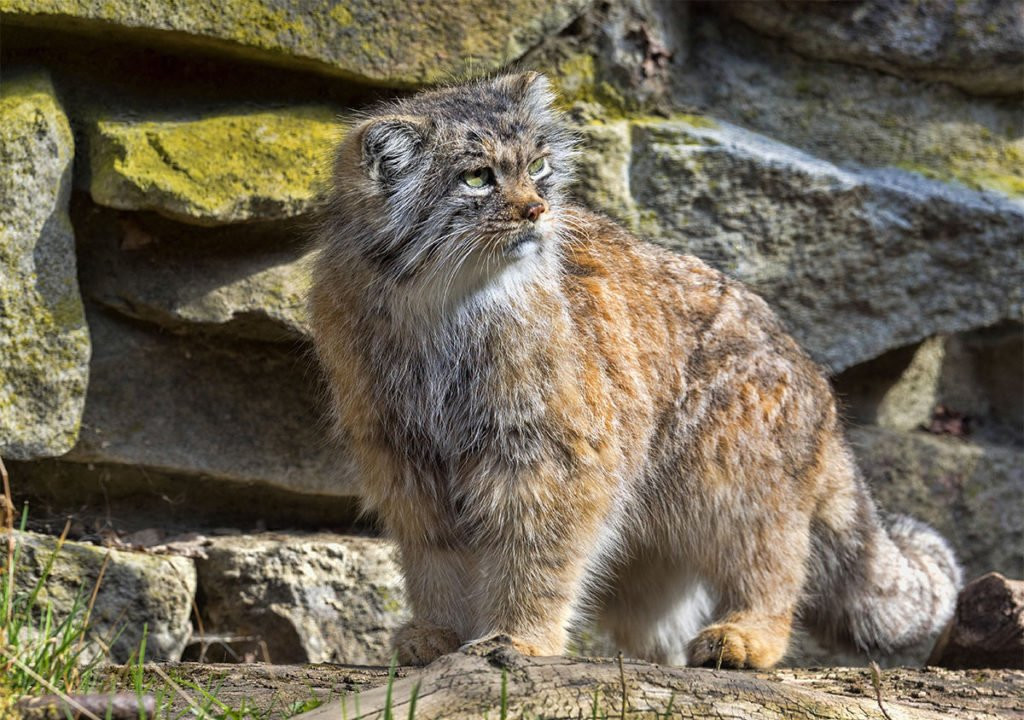 All types of wild cats – Pallas Pallas’s cat IUCN Status: Near Threatened
All types of wild cats – Pallas Pallas’s cat IUCN Status: Near Threatened
Also known as the Manul, the Pallas’s cat possesses the longest and densest fur of any cat species. This luxurious coat is essential for survival in the windswept, rocky slopes of Central Asia, its preferred habitat. Rocky environments offer shelter in caves, crevices, or even marmot burrows. Pallas’s cats primarily prey on pikas and voles, occasionally taking birds as well.
Pallas’s cats are not built for speed, relying instead on camouflage and stillness to avoid detection. When disturbed, they often freeze, becoming virtually invisible against the grey, rocky terrain.
The Ruoergai grassland on the Tibetan Plateau in China’s Sichuan province is a prime location for Pallas’s cat sightings. During five days on the grassland, I observed at least three different individuals.
Rusty-spotted Cat (Prionailurus rubiginosus)
Rusty-spotted cat IUCN Status: Near Threatened
The rusty-spotted cat, the world’s smallest wild cat, is native to the deciduous forests of India and Sri Lanka. It reaches a maximum weight of 1.6 kg and a length of 48 cm. Despite its diminutive size, it exhibits a bold attitude, equally comfortable in trees and on the ground, where it hunts prey (primarily rodents and small birds) with rapid, darting movements.
Sri Lanka’s Wilpattu National Park is one of the best places to see the rusty-spotted cat in the wild. We observed a relaxed individual in the early hours of the night from Wilpattu Sanctuary road, the main road leading to the national park entrance.
Flat-headed Cat (Prionailurus planiceps)
Flat-headed cat in Khao Kheow Zoo, Thailand (Image by The Wildlife Diaries) IUCN Status: Endangered
The flat-headed cat, an endangered small cat, is found on the Thai-Malay Peninsula and the islands of Borneo and Sumatra. This unique feline leads a semi-aquatic lifestyle, inhabiting riverbanks and hunting aquatic vertebrates. An excellent swimmer, it possesses remarkable adaptations for aquatic hunting. Its claws are not fully retractable, providing better grip on slippery riverbanks. Its feet are semi-webbed, aiding in wading through water. Long, sharp canine teeth are ideal for seizing slippery aquatic prey.
These specialized cats are threatened by the increasing destruction of riverine forest habitats due to conversion for oil palm plantations, human settlements, and agriculture.
The lower Kinabatangan River in Borneo, near Sukau village, is the most reliable location for sightings. After four nights of searching, I observed a single individual.
Fishing Cat (Prionailurus viverrinus)
Fishing cat in Sri Lanka. Image by The Wildlife Diaries IUCN Status: Endangered
Unusually for cats, fishing cats are not only comfortable in water but depend on it for sustenance, much like the flat-headed cat. Both species primarily hunt fish and small aquatic vertebrates.
The fishing cat has a wider distribution across South and Southeast Asia. Sri Lanka, particularly around Sigiriya and the outskirts of Wilpattu National Park (the park itself is inaccessible at night), offers the best viewing opportunities.
We observed fishing cats in both locations, though Sigiriya sightings were distant. The fishing cat near Wilpattu was curled up practically beside a farm road.
Mainland Leopard Cat (Prionailurus bengalensis)
IUCN Status: Least Concern
The mainland leopard cat is the most widespread of all Asian small cats, ranging across South, Southeast, and East Asia. This adaptable species tolerates human disturbance and is often found in rural areas and even oil palm plantations.
Sunda Leopard Cat (Prionailurus javanensis)
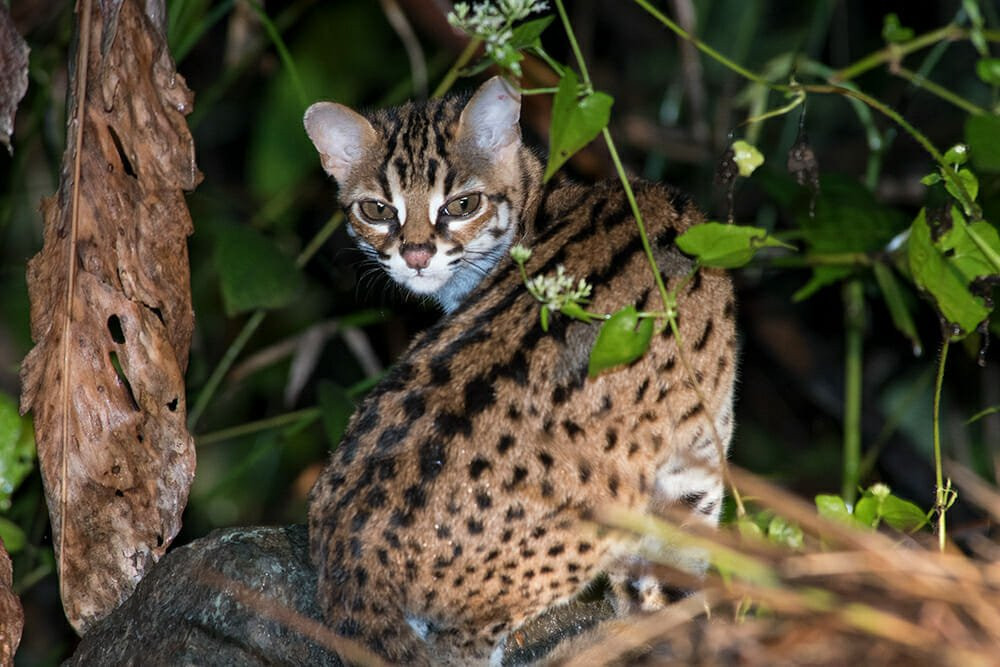 Wild cat species of the world – Sunda leopard cat in Deramakot Forest Reserve Sunda leopard cat in Deramakot, Borneo (Image by The Wildlife Diaries)
Wild cat species of the world – Sunda leopard cat in Deramakot Forest Reserve Sunda leopard cat in Deramakot, Borneo (Image by The Wildlife Diaries)
In 2017, the Sunda leopard cat, found on Borneo and Sumatra, was recognized as a distinct species from the mainland leopard cat based on genetic analysis. It is common in Borneo, and I have observed it in both Danum Valley and Deramakot Forest Reserve.
Felis Lineage: Youngest Branch of Wild Cats
The Felis lineage, the most recent to diverge from the common ancestor, comprises six closely related small wild cat species distributed across Africa and Eurasia.
Jungle Cat (Felis chaus)
Jungle cat IUCN Status: Least Concern
The jungle cat, also known as the swamp cat, is a medium-sized cat found from the Middle East to South and Southeast Asia and southern China. Jungle cats are typically diurnal, hunting throughout the day.
I have observed jungle cats during daylight hours in Kanha Tiger Reserve in India and at night near Sigiriya in Sri Lanka. Unfortunately, neither sighting was close enough for good photography.
Black-footed Cat (Felis nigripes)
 Type of small wild cat – Black-footed cat Black-footed cat IUCN Status: Vulnerable
Type of small wild cat – Black-footed cat Black-footed cat IUCN Status: Vulnerable
Africa’s smallest wild cat, the black-footed cat, is the second smallest wild cat globally, after the rusty-spotted cat. A highly efficient hunter with an astonishing appetite, it can consume up to 3,000 rodents annually. Nicknamed the “anthill tiger,” it shelters in abandoned termite mounds and hunts in the surrounding savannah.
The black-footed cat has a limited distribution in southern Southern Africa. Marrick Farm Safari in South Africa is the best place to observe this species.
Sand Cat (Felis margarita)
Sand cat IUCN Status: Least Concern
The sand cat, a true desert dweller, inhabits the deserts of North Africa, the Middle East, and Central Asia. While not threatened, it is not easily seen in the wild.
Sand cats possess incredibly dense fur, protecting them from cold desert nights. Thick black fur strands on their paw soles insulate them from scorching sand.
Most sand cat sightings are reported from Western Sahara and Jebil National Park in Southern Tunisia.
Chinese Mountain Cat (Felis bieti)
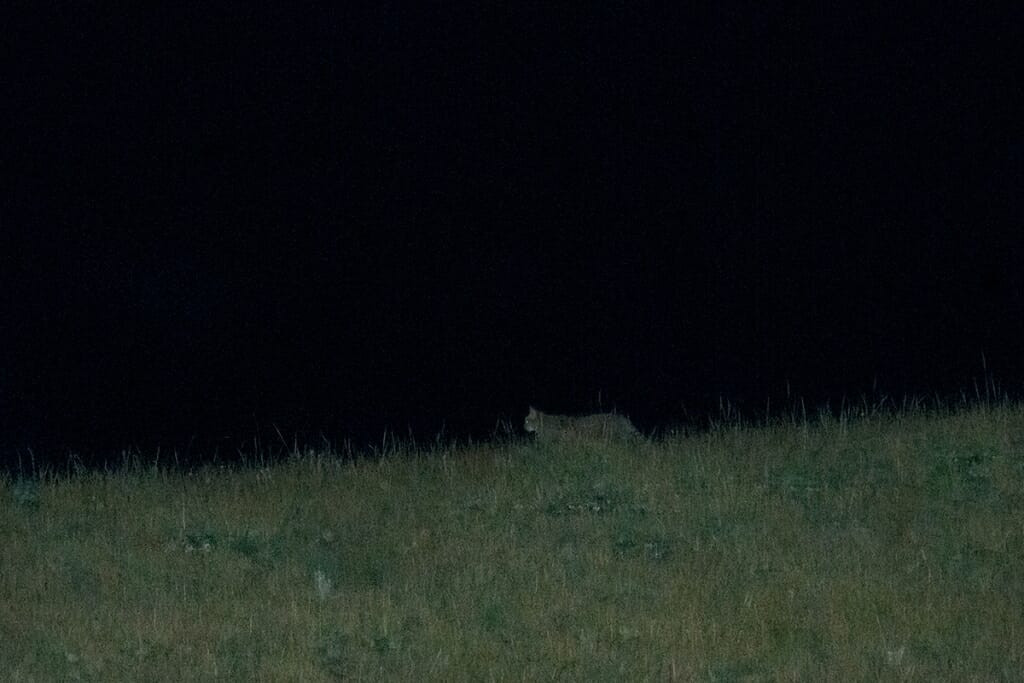 Rare wild cat – Chinese Mountain Cat Chinese Mountain Cat disappearing into the darkness on the Tibetan Plateau (The Wildlife Diaries) IUCN Status: Vulnerable
Rare wild cat – Chinese Mountain Cat Chinese Mountain Cat disappearing into the darkness on the Tibetan Plateau (The Wildlife Diaries) IUCN Status: Vulnerable
One of the least known and rarely seen wild cats, the Chinese mountain cat, was not photographed in the wild until about a decade ago. It has a limited distribution in Western China.
I observed the Chinese Mountain cat on the Ruoergai grassland on the Tibetan Plateau. During four nights, I saw cats on three separate occasions, making it a reliable location.
African and Asiatic Wildcat (Felis lybica)
African wildcat After recent taxonomic revisions, wildcat species have been divided into African and Asiatic wildcat and European wildcat. I observed the African wild cat at Kapama Reserve, near Kruger National Park in South Africa. Kafue National Park in Zambia is also suggested as a good location for wildcat sightings.
European Wildcat (Felis silvestris)
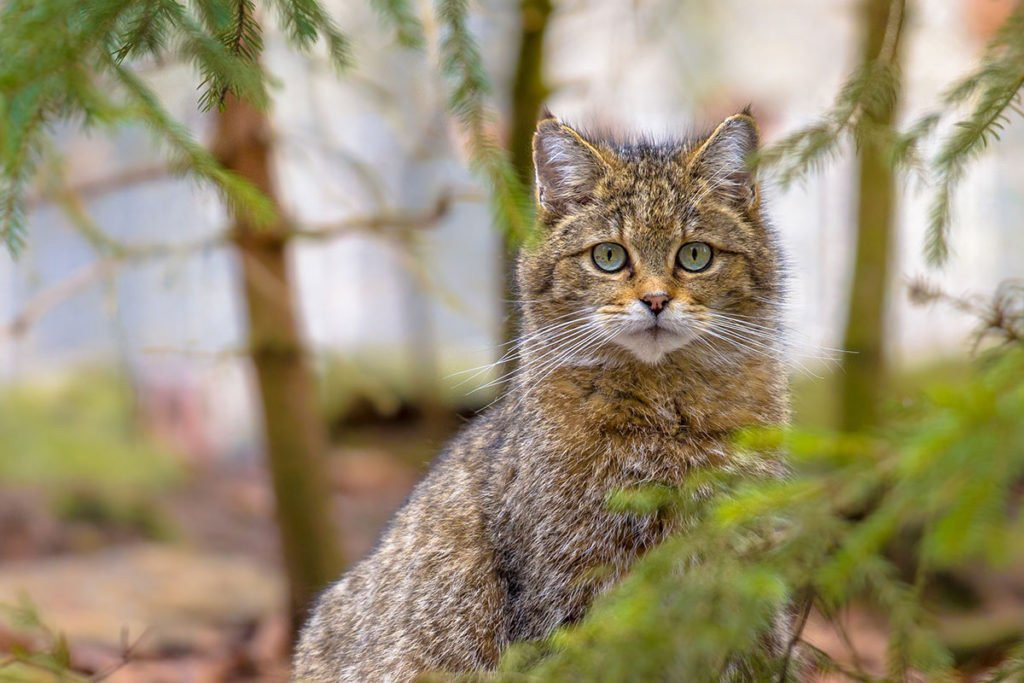 European wildcat European wildcat IUCN Status: Least Concern
European wildcat European wildcat IUCN Status: Least Concern
The European wildcat has a fragmented distribution across forests in Western, Southern, Central, and Eastern Europe, extending to the Caucasus Mountains. Cordillera Cantabrica in northern Spain, particularly the fields around Boca de Huergano, is a good place to search for European wildcats.
The Scottish wildcat is a well-known subspecies of the European wildcat.
The Looming Threat: Wild Cats on the Brink
Wild cats face a multitude of human-induced threats, including habitat loss and fragmentation, decline in prey populations, and persecution due to perceived or real conflicts with human livelihoods. Consequently, 25 wild cat species are currently facing the threat of extinction.
Five species are categorized as Endangered on the IUCN Red List of Threatened Species: tiger, Borneo bay cat, Andean cat, fishing cat, and flat-headed cat.
Thirteen additional wild cat species are listed as Vulnerable: lion, leopard, snow leopard, clouded leopard, Sunda clouded leopard, African golden cat, northern oncilla, southern oncilla, guina, cheetah, black-footed cat, Chinese mountain cat, and, as of 2024, the Iberian lynx has been downgraded from Endangered to Vulnerable, a testament to successful conservation efforts.
Seven wild cat species are classified as Near Threatened: jaguar, Asiatic golden cat, marbled cat, margay, colocolo, Pallas’s cat, and rusty-spotted cat.
Unveiling the Rarest Wild Cat
Determining the absolute rarest wild cat species is challenging due to limited data on some of the most elusive felids. The Amur leopard is undoubtedly among the rarest, with fewer than 90 individuals surviving in the wild in the Russian Far East.
The Iranian cheetah population may be even smaller, but data is scarce due to fieldwork challenges in a politically unstable region.
The South China tiger may already be extinct in the wild, with no confirmed sightings since the late 1980s.
Have you encountered wild cats during your travels? Share your experiences in the comments below!
Further Exploration into Wild Cats
2694 shares
